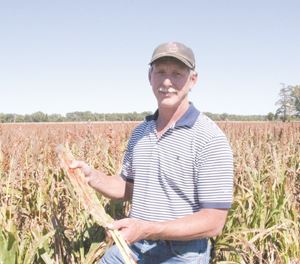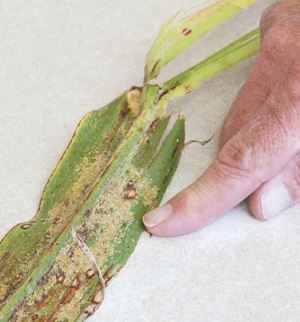|
Sugarcane Aphid Dining On Sorghum
Infestations Heavy Enough To Clog Combines
REGINA LAROSE
MidAmerica Farmer Grower
WINNSBORO, LA.
LSU AgCenter entomologist Dr. David Kerns said sorghum growers have an uninvited guest, pest, moving in. Sugarcane aphids have been a pest in Louisiana since 1997, but in 2013 it seems to have made a shift from sugarcane to sorghum.
“It was first detected in south Louisiana and in the Beaumont area of Texas. It quickly spread north into central Louisiana, south all the way to the Rio Grande Valley and into northern Mexico. By the end of 2013 it had moved all through Louisiana, parts of southern Oklahoma and in parts of Mississippi. This year the sugarcane aphid has gone as far as the high plains of Texas, southern Kansas and as far east as Georgia, South Carolina; as far north as Missouri and Tennessee,” said Kerns.
“The sugarcane aphid does fly. It is a very small insect, it is going to float on the wind,” he explained.
The sugarcane aphid loves Johnsongrass. “Anything that is sorghum related really, so if there is any Johnsongrass or any grain sorghum around, it will find it, it can kind of hop from spot to spot on those hosts.”
Kerns was asked what caused the massive expansion over the past two years. “Frankly, we don’t have an answer. We have some speculation. It could be a new biotype, it could have been that this aphid switched. It may have had some genetic alterations in it that changed the host range. The one that we see on sorghum definitely prefers sorghum, it does not like sugarcane. There are still aphids you can find in sugarcane but they are different. They are almost like different races of the same aphid. There is speculation that we are dealing with two species. This is highly debated in the world of academia. Hopefully, we have some people doing some genetics work and will figure that out before too long. DNA work should be done by the next growing season.”
The damage caused by the aphid is fatal. “It kills the plant; it depends on the stage of growth. Seedlings, they will wither and die. As the plant matures, it can tolerate more aphids. If you get these aphids right before boot, you will see sterile heads. When the heads come out they are blank. There’s no seed in them. As you move along, post boot, you will see a reduction in yields; dramatic reduction sometimes,” stated Kerns.
The stickiness of aphids can cause havoc at harvest. “If aphids are in the field, when you put a desiccant on the sorghum, the aphids will move up to the head, there will be so many of them they can clog up a combine.”
On mature sorghum this aphid could average 1,000 per leaf or higher. “It is unbelievable, they will stack. It is like you couldn’t put another aphid on that leaf. If you know what you are looking for, you are not really going to confuse them with the other aphids. They are so much more prolific than most of the other aphids we run into. You will know when you have them, it is pretty impressive.”
Once aphids are found at the 1,000 per leaf level is it too late to treat? Kerns says it depends, “if it’s preheading it may very well be. You may kill them but when the head comes out it’s sterile. So then it’s a revenge spray. If you are at grain fill, then I’d say no. You can preserve some of your yield by going ahead and controlling them. We are thinking the threshold of what you really want to be tolerating is about 50 to 100 aphids per leaf. I’m leaning at least until we know more about it; I want to be more conservative and lean more to that 50 aphid per leaf threshold.”
Kerns has seen aphid infestations upwards of 3,000 aphids. “That’s per leaf. We have seen leaves on big leafed sorghum; that has a lot of surface area; you may have 10,000 aphids on it. It’s just phenomenal how many aphids will get on a leaf. At some point, on those really heavy populations, they will develop a lot of alates, winged aphids. When an aphid gets crowded or their host quality begins to deteriorate, that is going to prompt them to develop wings. You will see a lot of them develop wings and disperse.”

You will know when you have them,
it is pretty impressive” said
Dr. David Kerns, LSU AgCenter
entomologist about the sticky
sugarcane aphid pest.
Photos by John LaRose

Kerns said the sugarcane aphids are
so much more prolific than most of the other
aphids they run into. There can be as many as
80-100 per square inch on a leaf.
Research is going on in other states. “There’s quite a bit going since Texas had the aphid pretty extensively in 2013. We have research going on at the LSU AgCenter. Oklahoma did a number of insecticide trials this year as well as researchers in Mississippi, Arkansas, Tennessee and Georgia.”
What will happen next year? Will it get into Kentucky and Illinois? “I wish I could answer that. We don’t know. What was interesting, in 2013 of course we had the same question, what is this thing going to do next year, and I thought after that extremely cool, cold winter we had that maybe not; that maybe it would be relegated to really southern parts of the state. That wasn’t the case. We had it and it spread fast. I think it has the potential of spreading further. It is on the Texas high plains right now and they are under pretty cool conditions.”
Some of the work Kerns is doing involves thresholds. “Action thresholds, when you should spray. We are also working with plant resistance. There are sorghum lines that are resistant to the aphid. A lot of these lines are old, they are not necessarily commercially available but it does provide something for our sorghum breeders to work with. I think in the long term the solution to this aphid is going to be host plant resistance. We just got to manage it until we get to that point.”
Kerns will be speaking the upcoming 18th Annual National Conservation Systems Cotton & Rice Conference, the Southern Corn & Soybean Conference and the Southern Precision Ag Conference in Baton Rouge, Louisiana on January 14-16, 2015. Kerns will explain some treatment options for proper management of this aphid. ∆
REGINA LAROSE: Associate Editor, MidAmerica Farmer Grower
|
|